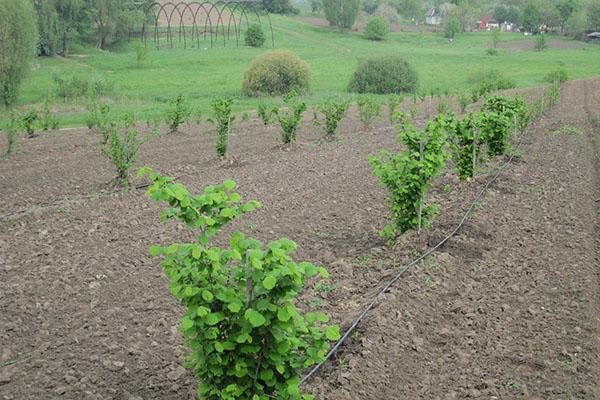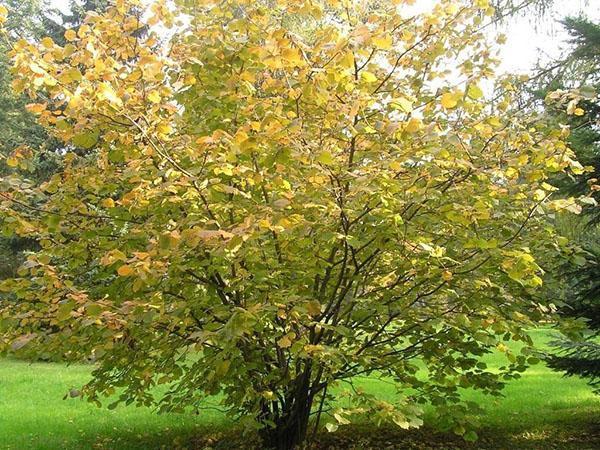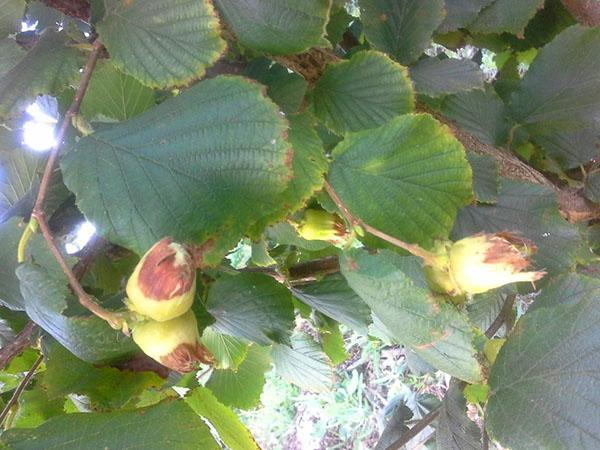What is the difference between planting and growing hazelnuts
 Planting and growing hazelnuts in a personal plot will not be difficult, since this culture is unpretentious, requires only minimal maintenance. In addition, breeders have developed various varieties that can be grown in regions with different climates, including in rather harsh regions.
Planting and growing hazelnuts in a personal plot will not be difficult, since this culture is unpretentious, requires only minimal maintenance. In addition, breeders have developed various varieties that can be grown in regions with different climates, including in rather harsh regions.
Description of the appearance of the plant

Hazel is a monoecious plant, bisexual, since the flowers of both sexes are formed on the same shrub.
Under good conditions, hazelnuts grow up to 3 m tall. It is presented in the form of a deciduous bush. The leaves of the nut are large, oval or heart-like. The color is deep green. Large-leaved varieties are used as ornamental plants in landscape design.
Barcelona hazelnuts
 The variety forms a dense crown, grows strongly, and is resistant to frost. The bushes reach 5 m in height, covered with large light leaves. Nuts can be of different shapes: slightly flattened or with three sides, large. The shell is thick and strong. It has a reddish brown color. The kernels are large, filling the entire nut. The fruits are tasty and sweet, juicy, without excessive fiber. They ripen in early September.
The variety forms a dense crown, grows strongly, and is resistant to frost. The bushes reach 5 m in height, covered with large light leaves. Nuts can be of different shapes: slightly flattened or with three sides, large. The shell is thick and strong. It has a reddish brown color. The kernels are large, filling the entire nut. The fruits are tasty and sweet, juicy, without excessive fiber. They ripen in early September.
Cosford
 This variety can be called an average frost tolerance. Large dark green leaves turn red with the onset of autumn. During the early flowering period, the bush is covered with long burgundy catkins. The shell is thin, initially yellow with a brown tint; when ripe, it turns red and darkens. The shell is easily detached from the core. It does not completely fill the shell, has a fibrous skin, slightly flattened or rounded. Light, cream-colored fruits ripen at the very end of September.
This variety can be called an average frost tolerance. Large dark green leaves turn red with the onset of autumn. During the early flowering period, the bush is covered with long burgundy catkins. The shell is thin, initially yellow with a brown tint; when ripe, it turns red and darkens. The shell is easily detached from the core. It does not completely fill the shell, has a fibrous skin, slightly flattened or rounded. Light, cream-colored fruits ripen at the very end of September.
Gaulish hazelnut aka Galle
 It grows in the form of a huge bush, towering 5.5 m, the crown is not too thick. The leaf plates are dark, slightly rough to the touch, fleecy. Blooms simultaneously with most varieties of hazel, forming bunches of male inflorescences of 5-6 pieces. Their length reaches 7 cm, and the diameter is 5 cm. The shell turns yellow as it ripens, it is easily separated from the kernel.
It grows in the form of a huge bush, towering 5.5 m, the crown is not too thick. The leaf plates are dark, slightly rough to the touch, fleecy. Blooms simultaneously with most varieties of hazel, forming bunches of male inflorescences of 5-6 pieces. Their length reaches 7 cm, and the diameter is 5 cm. The shell turns yellow as it ripens, it is easily separated from the kernel.
If you are engaged in the cultivation of hazelnuts in the Moscow region, then it is better to opt for the Akademik Yablokov variety. The beautiful, bowl-like bush yields up to 10 kg per plant. Fruits resemble acorns, grow in clusters of 10 pieces.
Planting and growing hazelnuts on the site
 The culture is unpretentious in the choice of soil. It is permissible to plant shrubs on level ground or on slopes. Any soil is suitable, except for highly saline, swampy and sandy soil. You should not plant a crop on the southern sides of the slopes, this will lead to early flowering of the shrub, which is fraught with damage to them by night spring frosts. Groundwater should be no closer than 1.2-1.5 m to the surface, and hazelnut plantings should not be flooded with water.
The culture is unpretentious in the choice of soil. It is permissible to plant shrubs on level ground or on slopes. Any soil is suitable, except for highly saline, swampy and sandy soil. You should not plant a crop on the southern sides of the slopes, this will lead to early flowering of the shrub, which is fraught with damage to them by night spring frosts. Groundwater should be no closer than 1.2-1.5 m to the surface, and hazelnut plantings should not be flooded with water.
It is preferable to plant hazelnut bushes in areas where there are no strong drafts and gusts of wind.
Hazelnuts with their superficial rhizomes are able to strengthen the slopes well, which is successfully used in many countries. In Italy, as well as in Turkey, it is specially planted in those places where other shrubs do not take root. This does not prevent hazel from giving a high yield.
In order for the culture to bear many fruits, several different varieties, at least two, should be brought in the same territory. Plant bushes at a distance of 4-5 m, no less. If only one variety is cultivated on the site, there will be few nuts from it.
Planting and growing hazelnuts
 Like other crops, hazelnuts can be planted twice a year: in the first two months of autumn or with the onset of spring, immediately after the soil thaws.
Like other crops, hazelnuts can be planted twice a year: in the first two months of autumn or with the onset of spring, immediately after the soil thaws.
Growing hazelnuts in Ukraine does not differ from caring for them in the Moscow region.
Hazelnuts need to be planted taking into account that this is a culture that is a long-liver, which grows significantly. A passage of 4-5 m should be left between individual shrubs, and when planting in rows, the optimal row spacing is about 6 m.If the plant is planted as a hedge, then the planting can be compacted, leaving only 2 m between the bushes. pollination and fruiting.
The dimples for planting should have a depth of 70 cm. Dig them out in advance. For spring planting, even in autumn, and for autumn planting, at least 1-1.5 months.
Planting stages:
- Humus (12-15 kg), superphosphate (200 g) and potassium sulfate (70 g) are poured onto the bottom.
- These fertilizers are mixed with the soil, then a mound is formed for planting.
- The rootstock of the seedling is immersed in a mixture of clay and manure, and then the roots are spread around this mound.
- The hole is covered with earth, while the root collar of a young hazelnut should be flush with the soil or 2 cm above it.
- A hole is formed around the plant, each bush is carefully watered with two buckets of water.
- They hide the earth (mulch) any plant material.
After the procedure, the plant is cut to 15-20 cm. At first, especially if it is spring, young hazelnuts need protection from the bright sun.
How to properly care for hazelnuts in the garden
 Plant care provides for regular loosening of the topsoil 15 cm thick. At the same time, weeds are removed, the space around the shrub is mulched with sawdust, grass or peat. Also, we must not forget about watering and feeding the plant, pruning it and protecting it from parasites.
Plant care provides for regular loosening of the topsoil 15 cm thick. At the same time, weeds are removed, the space around the shrub is mulched with sawdust, grass or peat. Also, we must not forget about watering and feeding the plant, pruning it and protecting it from parasites.
Watering. To ensure high yields, it is important to observe the crop watering regime, especially at the beginning of summer. To do this, in dry times, pour a bucket of water under each bush.
Top dressing. Hazelnuts are not often fed. Once every 2 or 3 years, 5 kg of compost mixture should be applied or humus (organics) for each copy. Hazelnuts react well to the introduction of nitrogen compounds (urea, ammonium nitrate) into the soil. They are brought in no more than 100 g per specimen in the spring and with the onset of summer. Twice a season, it is important to provide the nut crop with minerals through top dressing. The simplest option is OMU fertilizer (universal), it is organomineral. Top dressing is applied after watering or during a rainy period. Fertilizers are a prerequisite for a good nut harvest.
 Pruning. The crown is formed at the very end of autumn. This is important because correct pruning provides light access to the fruit to ripen well. The bush is formed before the crop begins to bear fruit (up to 4 years). From 8 to 10 trunks are chosen as a basis. Excess shoots in the middle of the crown are cut off, and the side shoots are simply taken to the sides and fixed with wire to provide ventilation and sufficient illumination.
Pruning. The crown is formed at the very end of autumn. This is important because correct pruning provides light access to the fruit to ripen well. The bush is formed before the crop begins to bear fruit (up to 4 years). From 8 to 10 trunks are chosen as a basis. Excess shoots in the middle of the crown are cut off, and the side shoots are simply taken to the sides and fixed with wire to provide ventilation and sufficient illumination.
To obtain the desired result, the nesting method of planting hazelnuts is also used.
Harvest. The ripening time of nuts depends on the variety of hazelnuts, most often the crop bears fruit from August to September. At the same time, the wrappers on the nut change color to yellow, then brown.The nuts are simply shaken off the branches, the strongest are cut off. Dry the fruits in the sun or in a well-ventilated room, scattering them in one layer. Then it is cleaned of the remnants of the wrappers and finally dried. In this state, hazel fruits are suitable for several years.
Potential pests
 The main threat to the hazelnut harvest is the weevil. To protect the culture from this pest, it is necessary to treat it twice with systemic drugs. Aktara and Angio will do, as well as Calypso. Treatment should be carried out when insects are just emerging. The first procedure is carried out in early May, and then, when they are actively postponing.
The main threat to the hazelnut harvest is the weevil. To protect the culture from this pest, it is necessary to treat it twice with systemic drugs. Aktara and Angio will do, as well as Calypso. Treatment should be carried out when insects are just emerging. The first procedure is carried out in early May, and then, when they are actively postponing.
They love to eat the hazelnut rhizome of the ubiquitous May beetle. If there are more than 2 larvae per square meter, then it's time to process the territory. Only then plant the hazelnuts. The best way is to sow lupines or buckwheat on the territory a year before planting, which the May beetle does not tolerate. Otherwise, you will have to resort to special chemicals.
Knowing how hazelnuts grow and how to care for them, you can get a beautiful plant that will give a bountiful harvest.